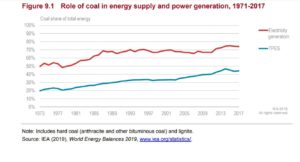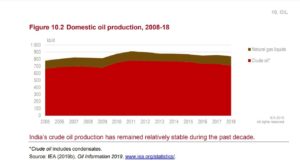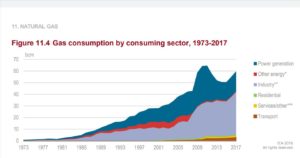Companion@360 → 7 Month programme to sharpen your writing skills → REGISTER NOW

Issues of Conventional Energy Sources
The consumption of energy in petajoules from Coal and Lignite was highest which accounted for about 46.8% of the total consumption during 2018-19 followed by Crude Oil (33.2%) and Electricity (12.9%).
While percapita consumption of energy has consistently increased during the years 2011-12 to 2018-19 with a CAGR of 2.30%, energy consumed for producing one unit of Gross Domestic Product has decreased during the period (CAGR (-) 1.92%).
Coal:
India is the world’s second-largest producer of coal after the People’s Republic of China. The share of coal in both the energy mix and the power mix in India has been increasing since the 1970s and in 2017 coal provided 44% of the total primary energy supply (TPES) and 74% of electricity generation.
Coal is the most abundant fossil fuel resource in India, although Indian coal is generally of poor quality, with high ash content and low calorific value.
Oil
- Oil remains an essential energy source for India. It is the second-largest source in the country’s total primary energy supply (TPES) and the largest in its total final consumption (TFC).
- Oil demand has increased rapidly over the last several decades and India is now the third-largest oil-consuming country in the world.
Natural Gas:
- India’s natural gas consumption is small but increasing. Most gas is used in the industrial sector and in power generation.
- Residential gas consumption is small, but India is expanding its gas distribution networks rapidly, an area where major growth is expected.
- India aims to increase the share of natural gas to 15% of the energy mix by 2030 (PNGRB, 2013), which suggests a doubling of current demand and infrastructure needs, as part of a gas trading hub.
- This will require the availability of transport capacity across India, which will enable all market players to access LNG supplies.
- Under the Petroleum and Natural Gas Regulatory Board (PNGRB) Act 2006, gas pipelines were declared common carriers/contract, and non-discriminatory third-party access is mandatory.
Challenges of conventional energy:
- Ozone depletion
- Global warming
- Acid rain
- Accessibility Challenge
- Policy Challenges
- Lack of skilled manpower
- Lacks transportation infrastructure
- Economic challenges
Way Forward
- The INDIA ENERGY SECURITY SCENARIOS, 2047(IESS)
- Augment refining and distribution of oil and gas.
- Improve India’s Energy diplomacy
- Promot Renewable Energy
- Hydrocarbon Exploration and Licensing Policy (HELP)
- Tax structure should be rationalized
- National Mission for Enhanced Energy Efficiency (NMEEE) should conduct a thorough cost-benefit analysis of the available energy-efficient technologies and products across all sectors, especially agriculture, housing and transportation.
- Increasing accessibility to clean energy




